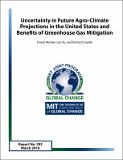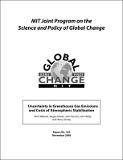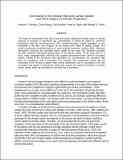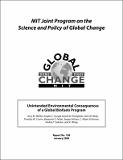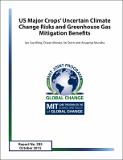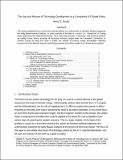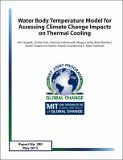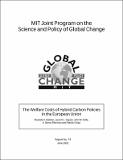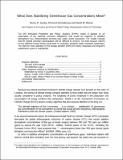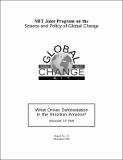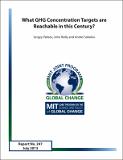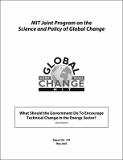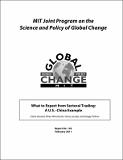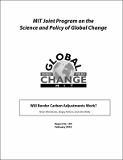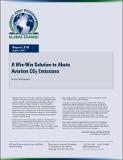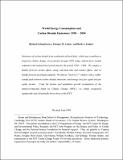Browsing Center for Global Change Science by Title
Now showing items 318-337 of 337
-
Uncertainty in Future Agro-Climate Projections in the United States and Benefits of Greenhouse Gas Mitigation
(MIT Joint Program on the Science and Policy of Global Change, 2016-03)Scientific challenges exist on how to extract information from the wide range of projected impacts simulated by crop models driven by climate ensembles. A stronger focus is required to understand and identify the mechanisms ... -
Uncertainty in future carbon emissions : a preliminary exploration
(MIT Joint Program on the Science and Policy of Global Change, 1997-11)In order to analyze competing policy approaches for addressing global climate change, a wide variety of economic-energy models are used to project future carbon emissions under various policy scenarios. Due to uncertainties ... -
Uncertainty in Greenhouse Emissions and Costs of Atmospheric Stabilization
(MIT Joint Program on the Science and Policy of Global Change, 2008-11)We explore the uncertainty in projections of emissions, and costs of atmospheric stabilization applying the MIT Emissions Prediction and Policy Analysis model, a computable general equilibrium model of the global economy. ... -
Uncertainty in the oceanic heat and carbon uptake and their impact on climate projections
(MIT Joint Program on the Science and Policy of Global Change, 1997-09)The impact of uncertainty in the rate of heat and carbon uptake by the deep ocean on climate response to increases in greenhouse gas concentrations is studied by means of numerical simulations with the two-dimensional ... -
Unintended Environmental Consequences of a Global Biofuels Program
(MIT Joint Program on the Science and Policy of Global Change, 2009-01)Biofuels are being promoted as an important part of the global energy mix to meet the climate change challenge. The environmental costs of biofuels produced with current technologies at small scales have been studied, but ... -
US Major Crops’ Uncertain Climate Change Risks and Greenhouse Gas Mitigation Benefits
(MIT Joint Program on the Science and Policy of Global Change, 2015-10)We estimate the costs of climate change to US agriculture, and associated potential benefits of abating greenhouse gas emissions. Five major crops yield responses to climatic variation are modeled empirically, and the ... -
The uses and misuses of technology development as a component of climate policy
(MIT Joint Program on the Science and Policy of Global Change, 1998-11)The current misplaced focus on short-term climate policies is a product both of domestic political exigencies and badly flawed technical analyses. A prime example of the latter is a recent U.S. Department of Energy study, ... -
The Value of Emissions Trading
(MIT Joint Program on the Science and Policy of Global Change, 2006-02)This paper estimates the value of international emissions trading, focusing attention on a here-to-fore neglected component: its value as a hedge against uncertainty. Much analysis has been done of the Kyoto Protocol and ... -
Valuing Climate Impacts in Integrated Assessment Models: The MIT IGSM
(MIT Joint Program on the Science and Policy of Global Change, 2012-05-22)We discuss a strategy for investigating the impacts of climate change on Earth’s physical, biological and human resources and links to their socio-economic consequences. The features of the integrated global system framework ... -
Water Body Temperature Model for Assessing Climate Change Impacts on Thermal Cooling
(MIT Joint Program on the Science and Policy of Global Change, 2015-05)We develop and test a physically based semi-Lagrangian water body temperature model to apply climatological data and thermal pollution from river-based power plants to historical river flow data in order to better understand ... -
The welfare costs of hybrid carbon policies in the European Union
(MIT Joint Program on the Science and Policy of Global Change, 2001-06)To what extent do the welfare costs associated with the implementation of the Burden Sharing Agreement in the European Union depend on sectoral allocation of emissions rights? What are the prospects for strategic climate ... -
What does stabilizing greenhouse gas concentrations mean?
(MIT Joint Program on the Science and Policy of Global Change, 1996-11)The MIT Emissions Prediction and Policy Analysis (EPPA) model is applied to an exploration of the national emissions obligations that would be required to stabilize atmospheric CO2 concentrations at levels now under active ... -
What drives deforestation in the Brazilian Amazon? : Evidence from satellite and socioeconomic data.
(MIT Joint Program on the Science and Policy of Global Change, 1996-12)This paper analyzes the determinants of deforestation in the Brazilian Amazon. From a model of optimal land use, it derives and then estimates a deforestation equation on country-level data for the period 1978 to 1988. The ... -
What GHG Concentration Targets are Reachable in this Century?
(MIT Joint Program, 2013-07-26)We offer simulations that help to understand the relationship between GHG emissions and concentrations, and the relative role of long-lived (e.g., CO2) and short-lived (e.g., CH4) emissions. We show that, absent technologies ... -
What Should the Government Do To Encourage Technical Change in the Energy Sector?
(MIT Joint Program on the Science and Policy of Global Change, 2005-05)Government support of innovation—both technology creation and technology demonstration—is desirable to encourage private investors to adopt new technology. In this paper, I review the government role in encouraging technology ... -
What to Expect from Sectoral Trading: A U.S.–China Example
(MIT Joint Program on the Science and Policy of Global Change, 2011-02)In recent United Nations Framework Convention on Climate Change (UNFCCC) negotiations, sectoral mechanisms were proposed as a way to encourage early action and spur investment in low carbon technologies in developing ... -
Will Border Carbon Adjustments Work?
(MIT Joint Program on the Science and Policy of Global Change, 2010-02)The potential for greenhouse gas (GHG) restrictions in some nations to drive emission increases in other nations, or leakage, is a contentious issue in climate change negotiations. We evaluate the potential for border ... -
Will Economic Restructuring in China Reduce Trade-Embodied CO2 Emissions?
(MIT Joint Program on the Science and Policy of Global Change, 2012-10)We calculate CO2 emissions embodied in China’s net exports using a multi-regional input-output database. We find that the majority of China’s export-embodied CO2 is associated with production of machinery and equipment ... -
A Win-Win Solution to Abate Aviation CO2 Emissions
(MIT Joint Program on the Science and Policy of Global Change, 2017-08)We outline a benchmark carbon dioxide (CO2) intensity system with tradable permits for the aviation industry that will incent in-sector emission abatement opportunities that cost less than the social cost of carbon (SCC). ... -
World energy consumption and carbon dioxide emissions : 1950-2050
(MIT Joint Program on the Science and Policy of Global Change, 1996-04)Emissions of carbon dioxide from combustion of fossil fuels, which may contribute to long-term climate change, are projected through 2050 using reduced form models estimated with national-level panel data for the period ...

